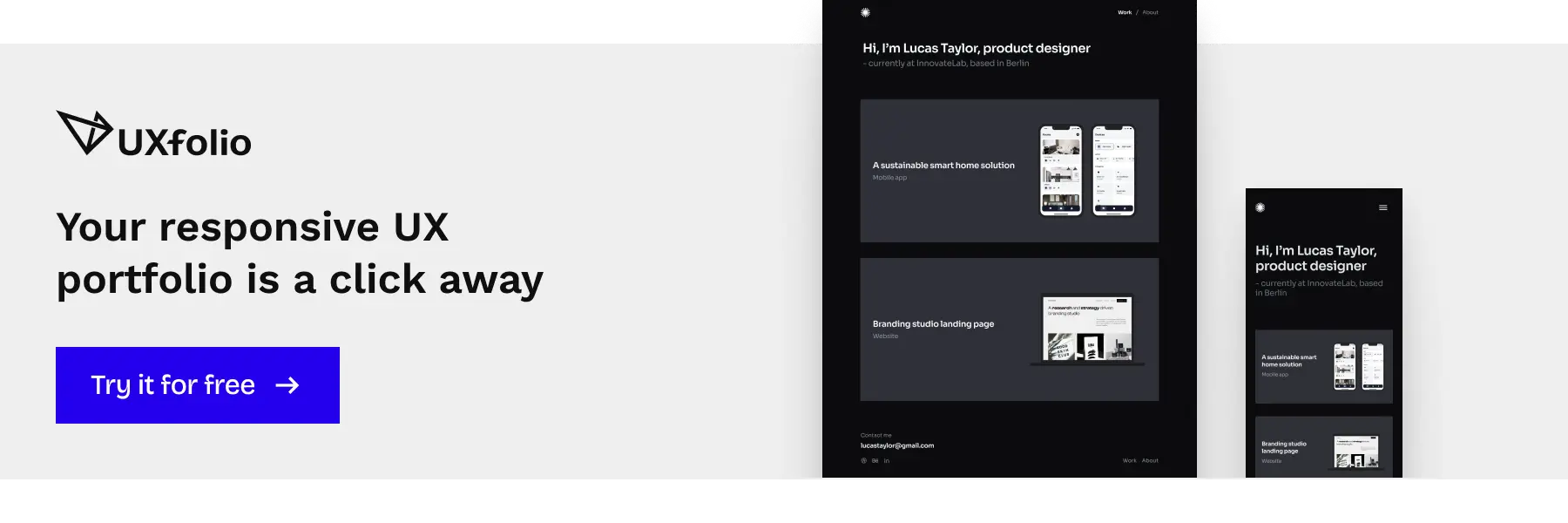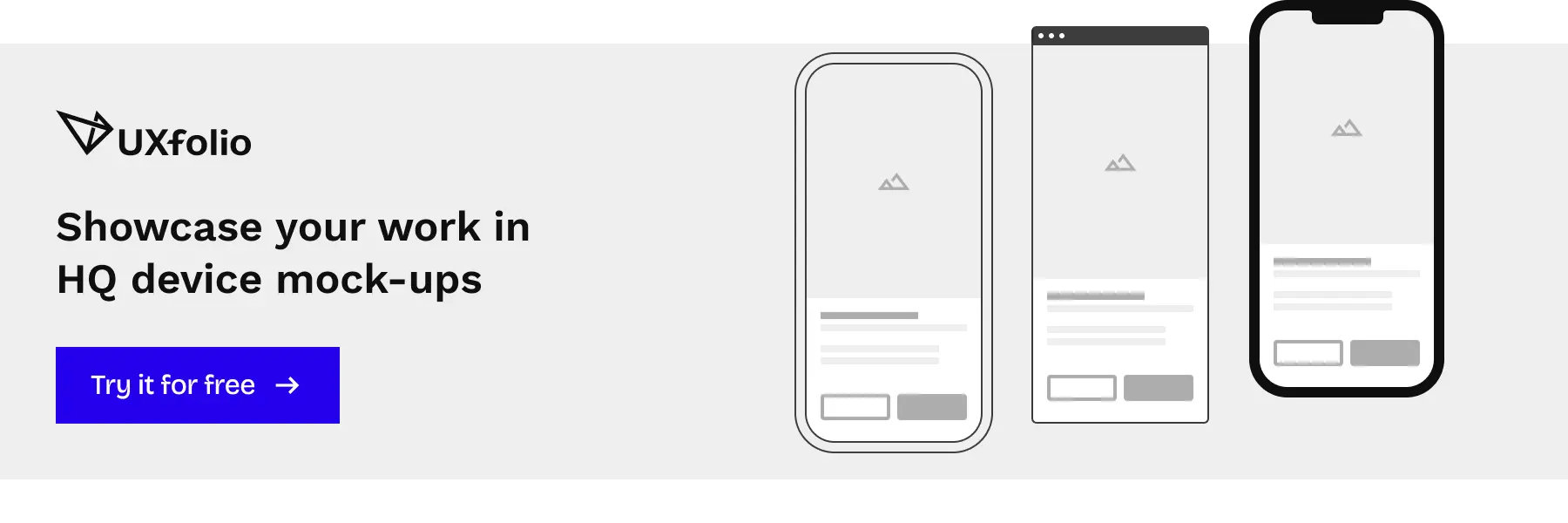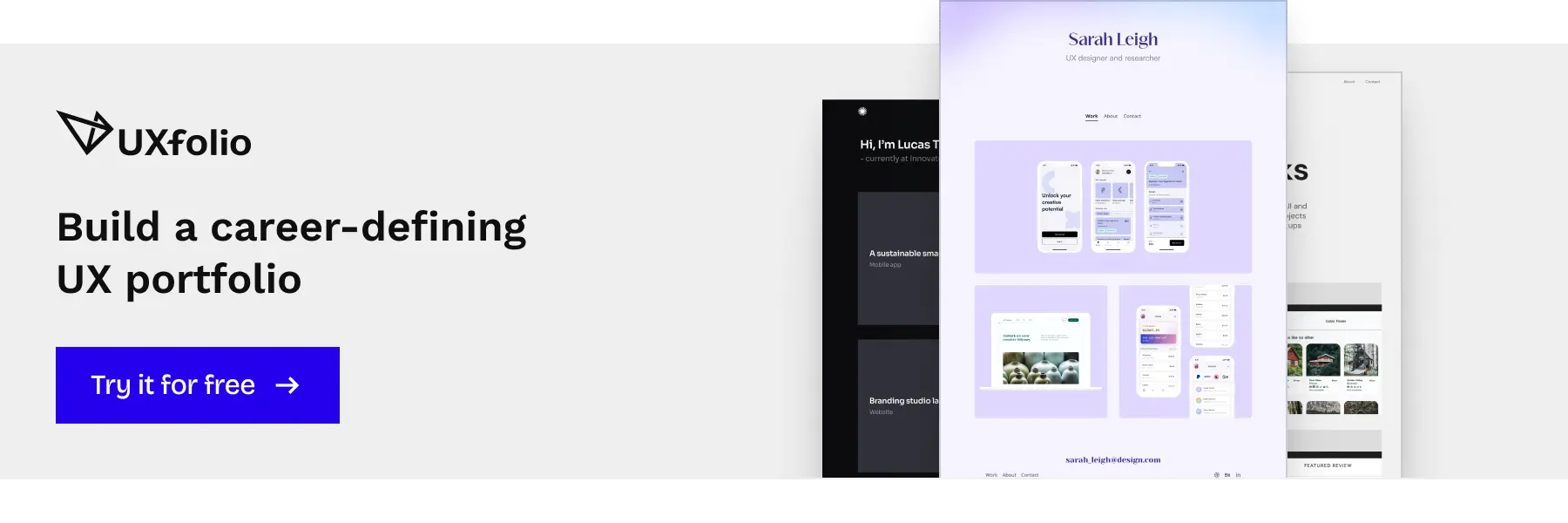Marc Greenberg is the UX Lead in Robotics at Postmates’ research and development branch. Together with his team, they are working on exciting and futuristic products like Serve, the innovative delivery robot that has been shared all over social media feeds.
I had the chance to ask Marc about his career, design process, artificial intelligence, machine learning, and design challenges during COVID-19. He shared many illuminating and inspiring examples from his work alongside a treasure-chest of priceless portfolio advice.
What was your journey to product design?
In undergraduate school, I didn’t really know what I wanted to do, so I took classes in anything that sounded interesting, from philosophy, astronomy, and physics to painting and creative writing. However, at one point I needed to declare a major to graduate. I went to the advisor, who recommended a “new program founded on philosophy, psychology, and cognitive sciences.” I went with it and took a few more courses in artificial intelligence, programming, and design. Eventually, I graduated with an interdisciplinary degree in ‘Philosophy in Cognitive and Computer Sciences’, which is the basis for my user-centered outlook and background.

How did you land your first product design job?
After graduating, I sent my resume all over the country. I decided that I’d accept the first job offer, regardless of what or where it was. The first response came from a financial advisory company in San Francisco, California, Charles Schwab & Co. Inc. I accepted their offer, moved to California, and started working as a Web Application Developer.
I knew how to code and I was drawn to front-end development for its direct impact on users. In the beginning, I didn’t know how to utilize my degree in my day-to-day work.
“The more curious you are and the more you learn about all the disciplines around you, the more successful you will be.”
At one point, when I was asked to build a screen, my background in psychology and philosophy prompted me to ask questions that designers tend to ask: Who’s going to use this? What are they trying to achieve? And so on.
Eventually, the product managers said, “Well why don’t you just design it?” So, I tried, and it made me realize how huge of an impact design has on users and the product. So, I went back to school to pursue a masters in HCI and to learn about the formal concepts.
And that’s how I entered design: through having an opinion on the things that I was building and focusing on the people that I was building them for.
Can you tell us a bit about Postmates X and how you joined the team?
X is the R&D division of Postmates that’s focused on longer-term bets that could make deliveries faster, more reliable, more efficient, and more accessible.
I joined Postmates X to lead a project that graduated into personalization and recommendation predictions around food. My background in psychology, artificial intelligence, and design is ideal for that sort of human-centered thinking.
Robotics was the other project going on inside of the R&D lab, right next to us. At that point, their team didn’t have a lead designer, only engineers. They would sometimes ask for my perspective and input. So, when my food recommendation project graduated, they brought me into the Robotics project.
What fascinates you in AI and machine learning?
Machines, programs, and applications do what you tell them to do. But they have a limited set of paths, established and built by a programmer. What’s more, everything in their system has a bias from that programmer.
Through science fiction and media, we are familiarized with the idea of machines being creative. The idea that they can exercise or learn rules and gain some form of knowledge that hasn’t been baked in by a programmer. That is the concept of general artificial intelligence, and we’re still very far from it. Machine learning, a subset of AI, is where we see practical applications of such concepts today.
Here’s an example that pertains to the robots we are working on at Postmates X: Humans can very easily understand where the edge of a sidewalk is when they’re walking, even if it’s covered with leaves and dirt, even if they’re walking in a new city, on a surface that they’ve never experienced. They can just extrapolate their previous knowledge into new areas. But how does a robot do the same?
How does a robot know where it can travel? What if there are leaves on the sidewalk? Is it still a sidewalk? Is it going to sink and tip over? That’s where artificial intelligence, more specifically machine learning, comes into the picture. It can make these machines more capable instead of programmers building a leaf recognition algorithm to understand what a leaf looks like on a sidewalk versus on the grass. It’s just fascinating, creative, and helpful.
Do you think AI poses a threat to creative jobs?
Currently, there’s a project training a machine learning model to create e-commerce storefront layouts based on the existing layouts that people have created on the platform. The idea is to create high-performing layouts for different types of shops. I don’t think something like this will take away from the creative industry. On the contrary, it’ll open it up.
“Where there’s automation in creative jobs, there’s room for creativity that automation frees up.”
Where there’s automation in creative jobs, there’s room for creativity that automation frees up. I could jump a number of steps in my process if I were using that AI to crank out 12 different effective layouts instead of spending many hours creating them myself. Then I could use those as a basis for my own creativity. So, I don’t believe AI will take over creative jobs or even pose a threat. I believe they’re helpful tools.

What do you do as a UX Lead?
As the experience lead, my job is to consider all touchpoints that the robots have with people, both physical and digital. First, there are the customers who use Postmates to order something. Then, there are the merchants who want to deliver goods, and we sign them up for robots on top of the traditional courier network.
For each delivery between a single merchant and customer, you may have hundreds of people who will experience the robot as it travels around cities. You have this device out there in the world, among people who most likely have never seen it and yet need to negotiate with and around it. We can treat people like obstacles, or we can try to put a smile on their face, or even help them out in certain circumstances. We consider merchants, customers, and the public every day.
What were the initial obstacles?
So many, whether it’s size, visibility, acceptance, access, or even city permits. San Francisco has been a little bit tech-phobic on the sidewalks and city streets. For a while, the city banned sidewalk scooters, and they were also considering banning sidewalk robots when a number of other companies forayed into that space.
We understood that in order to be permitted to operate in the public space, where we’re sharing infrastructure and negotiating right of way, we had to be very mindful and thoughtful of safety as well as perception. We’ve worked very hard on both of those.
Could you please tell is a bit more about that? How does the robot communicate with pedestrians on the sidewalk?
When the public meets the robot around the city, they can’t predict what it’s going to do; is it going to cut them off or get in their way? When we started designing a solution for this, we went through a couple of things. At first, we put an arrow on the screen of the robot to indicate the way it was going. After testing it, we realized that nobody knew what it was trying to signal: “Is it saying that I’m going to go left, or is it saying you should go left?” It was confusing for them.
If you think about how people communicate the way they are heading on the sidewalk, you’ll find that there’s a lot of body language at work. Also, we can detect signals as subtle as turning the shoulders. If you think about a cyclist or a skater, you’ll find that the ensuing motion is indicated by a whole-body lean, inertia, and the weight of movement.
But how do you translate this into a robot? We ended up using a combination of light, sound, and motion. But the perfect solution is still in the works.
How else could the robots’ technology be utilized by cities?
When you have such technology, a number of other potential uses emerge. We have a payload, perhaps we could carry critical medicines in a separate compartment? Put other sensors on them to measure air quality or other environmental aspects? Mapping cities and accessible routes?
The robots need to get around cities on wheels. There’s a whole segment of the population in wheelchairs, walkers, and other mobility devices fighting for their rights and for access. A wheeled robot relies on the same infrastructure as them. So, we could be an ally, collecting and providing data: Where are there no ADA compliant ramps? Where are the sidewalks uneven or damaged? You get the idea.
Can you give us an example of a challenge you’ve faced at Postmates X and how did you tackle it?
This is a very small example, but it’s also a very real one right now, because of COVID-19. When the merchant brings an order out to the robot, they have a special code that unlocks it to make sure they’re putting the right goods inside the robot. This is especially important when there are multiple robots waiting outside. The customers use the same code to access their goods.
The issue is that this solution requires at least two people to touch the same screen. Besides the digital keypad, the robots were almost a touch-free solution, which is very desirable during a pandemic.
So, we had to rapidly design and develop a way for merchants and customers to get their goods without touching the robot. Potential solutions included having a unique button on both the customer’s phone and the merchant’s tablet. But that would have taken too much time to do.
We have cameras on the robots, monitored by remote supervisors. Someone suggested that we should just have the supervisors open the lid remotely for the merchant. That’s a very simple solution, not something that would be maintainable for an extended period of time. Still, it enabled us to almost instantly roll out a touchless solution for the entire fleet.

That’s unexpected yet rational in this situation.
Yes, a solution that requires human monitoring and decision making instead of artificial intelligence, which has not been built or perfected yet. The ability to combine machine and human intelligence is really powerful and flexible. From a design perspective, what really matters is the net experience on both ends, the customers and merchants, but also our supervisors. It was a time of need. We needed to make people feel safe, and we were able to come up with an immediate solution.
“From a design perspective, what really matters is the net experience on both ends (…).”
Do you have a go-to design process at Postmates X?
Since I’m working on a project that includes various products, interfaces, and different forms of communication, my days and processes can be very different. Still, the foundation is similar across all the different modes and devices. It all begins by gathering experiences, requirements, and assumptions. Then it continues with sketching, designing, and validating solutions.
We usually work very closely with engineers because there isn’t a set way of working on mediums such as the LED light strip on the side of the robot that’s used for communication. So, we have to work very closely with both hardware and software engineers and of course test, test, and test. As we like to say “the truth is on the street.”
Which parts of the design process do you enjoy the most?
Feedback and storytelling. I start every morning by checking user feedback. Seeing how people are using your product is helpful in multiple ways. You’ll see people using it intuitively with joy, and delight, which validates your work and decisions. But you’ll also see them being utterly confused or frustrated in ways that you never expected.
Feedback helps you become a better designer and it enables you to design and build better products with lasting impact. It can be hard when all you have is a design concept, or when you’re doing a school project. But still, feedback is necessary, because it’s eye-opening and wonderful in many ways.
I also love storytelling and going beyond superficialities. Storytelling shows the human side of a solution. Take for example, the story of why we needed touchless delivery as fast as possible and how we solved the challenge. The story gives context and elegance to the solution.
“I’ve seen many junior designer portfolios where they describe what they did but not the buildup or the whys when in reality those are the details that draw people in.”
Also, storytelling is an underrated skill for designers. I’ve seen many junior designer portfolios where they describe what they did but not the buildup or the whys when in reality those are the details that draw people in.
How do you keep inspired?

I like free association and getting lost in my explorations. Wander, go far, then come back. If I’m reading articles or looking at other reference interfaces, logos, or designs, I’ll always check out the author. I’ll look up their tweets and posts, find out what else interests them and what else have they designed. This provides more context to why and how they came up with the solution. What’s more, it provides a lot more inspiration than just reading an article or looking at a logo. Even if it isn’t relevant to the problem I’m trying to solve, it still gives me a huge creative base to pull from when solving problems.
So you don’t look at designs specifically for inspiration?
I wouldn’t say that I don’t. For example, if I’m looking to communicate something on the robot screen, I may be looking at other screen designs. And then, while I’m doing that, I might find that I really enjoy the typography they’re using. So, I’ll go study the font foundry, and while doing that I might find a hand lettering artist that has nothing to do with my robot design. I definitely do start with parallels, I just allow myself to wander off.
Can you share a fun fact or misconception about product design?
“Doubting that you know how to solve a thing, letting that get in your way of drafting that first [solution] is the opposite of what designers do. They just try.”
This may be a cliche, but everybody is a designer. Even before I thought of myself as one, I was still using products and I had an opinion on them. Everybody is capable of pointing out issues and asking questions. Answering those questions is what designers do.
When I see my son getting frustrated as he is trying to draw something, I’ll ask him, “Do you want to know how to draw a really good lion?” He says, “Yeah, how do I draw a really good lion?” I answer, “You draw 100 really bad lions.”
Some people will take shortcuts, and that’s okay. They’ll look up how to draw a lion, or they’ll take anatomy classes to understand the body of a lion. Others will use tracing paper to trace another drawing. There are many ways to design, but doubting that you know how to solve a thing, letting that get in your way of drafting that first lion, is the opposite of what designers do. They just try.
You might see some designers with sloppy illustration style and others with incredibly neat illustrations. They’re both designers, especially if they can communicate their story. As long as you can tell the story behind your designs and communicate how they solve a problem, it works.
Do you think designers should strive to learn overlapping disciplines?
I’ve found it very rewarding to familiarize myself with the disciplines related to what I was working on. Whether it is engineering so you can implement those designs, analytics to study your designs, or product management and prioritization to figure out if you should build those crazy features that will have a huge impact but have a long timeline. It doesn’t have to be deep knowledge, but the more curious you are and the more you learn about all the disciplines around you, the more successful you will be.
What other advice would you give to up-and-coming designers?
“One of the interesting things I’ve learned is that when you share what you’re passionate about, the people around you will give you will opportunities to use them.“
Start close to you. Everyone can identify where their own frustrations, troubles, and difficulties lie. The first step is to design solutions to those things.
I volunteer at a UX meet up where young designers ask for advice, whether it’s on their portfolios or careers. There may be thousands of people trying to break into the field but only a very few can compete with you on your interests and passionately informed opinions.
Recently, I was chatting with an aspiring designer, whom I learned is a DJ on the side. I asked her about the tools she uses and whether she likes them. One of the tools she mentioned was Spotify. When I asked whether she loves it, she replied, “Yeah it’s okay, but it doesn’t really support independent artists that well. I need to support myself. I’ve got a Patreon page and some merch.” So, I asked her, “If you were redesigning Spotify, what would you do?” “Oh, well, maybe I would build a merch or a donation feature right into the artist pages to help support independent artists.”
She had real opinions and real problems. If I were hiring for Spotify or the music industry I’d want to talk to her over many other applicants. So, I advise you to feature such interests in your portfolio, right at the top. Aim for your endgame right from the start.
If you are transitioning to product design, start close to you. Start with something that you have strong opinions on. One of the interesting things I’ve learned is that when you share what you’re passionate about, the people around you will give you will opportunities to use them.

As a design lead what are you looking for in the designers you work with?
I look for people who are passionate about what they do. Also, something that I call a bias towards action. If you need to design something, but you don’t know whether it can be built, then go and figure it out: Start prototyping, tinkering, and talk to users or engineers or other designers.
Also, be willing to go broader than just your immediate discipline. You sometimes hear the phrase “stay in your lane.” I prefer designers who are willing to go outside of their lane, that brings a broadness to the team that really lends itself to designs that work well systemically, not just locally.
What makes a good product designer portfolio? What are you looking for while reviewing portfolios?
The first thing is storytelling. It’s not enough to show wireframes alongside a wall with Post-its or to briefly mention user testing, and card sorting. To tell an engaging story, you should share why did you use these methods and how did they help in the process. Just keep it concise.
Also, make sure that your are part of the story. You can achieve that by sharing personal stories or great examples. Show your understanding of the drive behind the product, otherwise, your reader is not going to learn about your involvement, and your understanding of the problem.
Do you have any additional portfolio or career advice?
“Storytelling is not about being verbose, it’s about being evocative.”
This goes back to a couple of things I’ve mentioned before. In order to be a good designer, whether it’s a graphic designer, an illustrator, a researcher, a product designer, you should start with what you know and what you can relate to. This way you’ll learn how to get your point of view across.
Also, presentation skills are huge. You shouldn’t simply list your skills. That would put your readers to sleep. Try to make everything into a story then get to editing. Walk away from your work. Come back the next day and reread it. Review it over and over again until you can distill it down to its core. Storytelling is not about being verbose, it’s about being evocative.
What do you think keeps someone relevant as a designer?
This ties in with the concept of experimenting outside your lane. One thing that I feel makes me effective in my career is my tendency to learn and try things. Building a network is also key. Very often, if I don’t know how to do something, I will know someone who does. People come to me for things that have nothing to do with design because they know I’ve spoken to everyone. I will know who can get it done if I can’t get it done myself.
Finally, a bias towards action. If you don’t know how to do something or get it done, consider just trying it, who knows, you may learn a new skill that becomes your life – that’s how I ended up in design. 😉
Thank you for sharing all these amazing examples and advice!
You can follow Marc at:
Start building your portfolio with UXfolio!
If you are looking for a quick and easy way to create a UX portfolio, try UXfolio! Our product is built with UX professionals in mind. It generates your portfolio website, a stunning portfolio cover page, and it helps you put together nice project case studies in minutes.
Also, UXfolio can help you in copywriting with great examples and guiding questions. And you can even ask for detailed, expert reviews on your case studies before applying for your next job.
Start building your meaningful UX portfolio with UXfolio.
Click here to sign up and try it out!